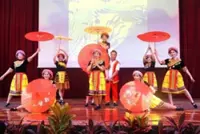The dramatic scenery of Glen Helen Gorge inspires painters such as Australia’s Albert Namatjira. — Photos: FLORIAN SANKTJOHANSER/dpa
For hours already, the hikers have been trudging uphill, above them a fantastically starry night sky. Some of the group have been hiking with heavy backpacks for weeks, others only a few days with lighter burdens.
But all of them have one common goal: To be standing atop Mount Sonder for the next sunrise. The night-time ascent is the final highlight of this very Australian pilgrimage, the 230km Larapinta Trail from the desert city of Alice Springs in the Northern Territory, through the West MacDonnell Range, a mountain chain in the red heart of the continent down under.





